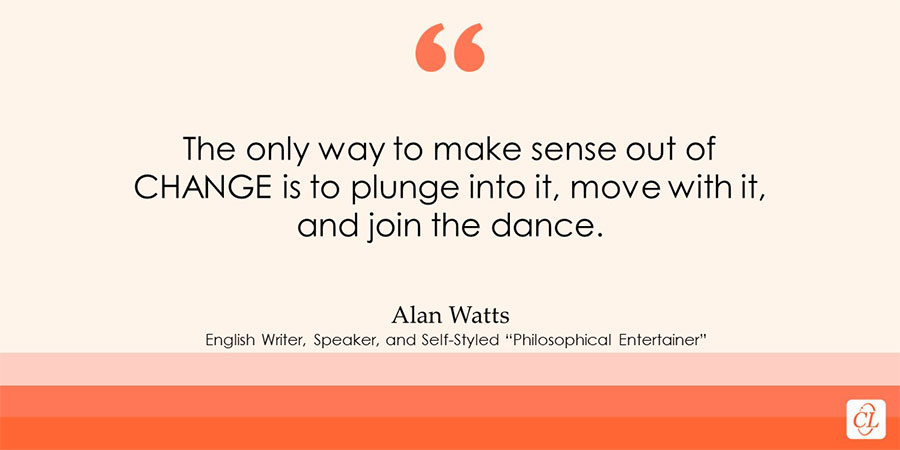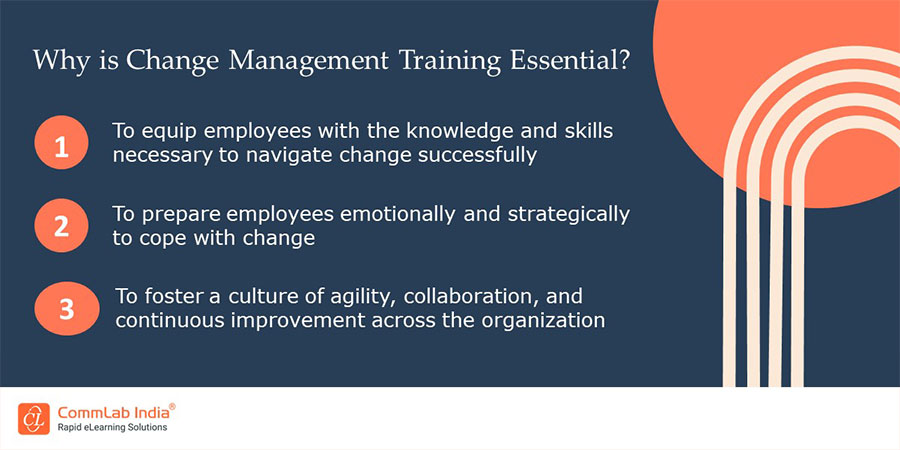7 Quintessential Tips to Design Effective Change Management Training Programs

The world is evolving continuously and change is inevitable. Change is not merely a buzzword; it’s a fundamental force that shapes the present-day corporate world. From technological advancements to shifts in market trends, and fast-changing customer needs, organizations are frequently required to adapt to new circumstances. This necessitates a proactive approach to managing change, especially within the realm of Learning and Development (L&D). As training managers, it is crucial to understand the significance of change and equip employees with the skills needed to navigate through it effectively. Read the blog for a comprehensive picture of change management and essential tips to design impactful change management training programs.
Change is Inevitable in Today’s Dynamic Business Landscape
Here are a few secret tips for designing unforgettable change management training programs:
- Assess Organizational Needs
- Define Clear Learning Objectives
- Customize Content and Delivery
- Promote Engagement of Key Stakeholders
- Provide Ongoing Support to Reinforce Learning
- Measure and Evaluate the Impact of Training
- Foster a Culture of Continuous Learning
Why Embracing Change is Important?
“To improve is to change; to be perfect is to change often.” — Winston Churchill. Embracing change is imperative for organizations to remain competitive and sustainable in today's dynamic business environment. Those who resist change risk falling behind or becoming obsolete. Here’s why embracing change is crucial:
- To win a competitive edge: Organizations that embrace change stay ahead of the curve. They innovate, optimize processes, and remain agile in a rapidly changing environment. This helps them win a competitive edge and seize new market opportunities.
- To foster employee engagement: Embracing change cultivates resilience among employees, enabling them to navigate uncertainties with confidence and adaptability. When employees understand and accept change, they feel more engaged. Engaged employees contribute positively to productivity and creativity, and also enjoy overall job satisfaction leading to higher retention and loyalty.
- To ensure seamless business continuity: What worked well in the past might become obsolete today. Organizations need to adapt to new trends to stay current. Effective change management ensures smooth transitions, minimizing disruptions, and maintaining operational efficiency and business continuity.

What is Change Management?
In today’s dynamic business landscape, innovation is the key to success. No wonder we see new products and services making their way into the market every other day. Naturally, this calls for changes in the processes, strategies, and the way of everyday business. Well, bringing a change is easy but the challenge is to effectively communicate it to the organization at large, and then implement it for desired results.
According to a research article on organizational change, change management is the structured approach to transitioning individuals, teams, and organizations from their current state to a desired future state. It involves thoughtful planning, effectively communicating, and implementing the changes. The aim is to minimize resistance and maximize adoption for seamless workflow. Change management encompasses various strategies, processes, and tools aimed at facilitating smooth transitions and achieving desired outcomes.
→ Download eBook: How L&D and Business Can Align to Conquer the Future of Work
Why is There a Need for Change Management Training?

Change management training is important for both employees as well as managers. It is essential to equip employees and leaders with the knowledge and skills necessary to navigate change successfully. For managers, it provides them with a deeper understanding of the change process, helps them manage resistance effectively, and empowers them to drive positive outcomes. It also allows them scope to think strategically to make necessary changes in the processes and techniques to best suit the changes
When it comes to employees, change management training prepares them emotionally to cope with change. Training on new skills, tools, technologies, and strategies equips employees to embrace change and execute it with confidence.
Additionally, change management training fosters a culture of agility, collaboration, and continuous improvement within the organization, enabling it to thrive amidst evolving circumstances.
How Can You Design an Effective Change Management Training Program?
Though it involves equal participation of employees as well as managers in change management training, the program should be designed to cater to the unique training needs of employees and managers. While the managers are trained on stuff like important decision-making during the implementation of new processes, guidelines, and workflows, employees are trained on ways to build adaptability and resilience to deliver with persistent operational efficiency. Here are a few essential tips that’ll help you design an impactful change management training program:
1. Assess Organizational Needs: Before designing a change management training program, conduct a thorough assessment of organizational needs and objectives. Identify specific challenges, areas for improvement, and desired outcomes to tailor the training program accordingly.
2. Define Clear Learning Objectives: Clearly define the learning objectives of the training program, ensuring alignment with organizational goals and desired outcomes. Ask your learners about the various aspects they would like training on to embrace change seamlessly and include them in your training program. Focus on building competencies such as change readiness, communication skills, technical skills, and leadership capabilities.
3. Customize Content and Delivery: Customize the content and delivery of the training program to meet the diverse needs of employees. Utilize a mix of instructional methods, such as workshops, simulations, case studies, eLearning, and microlearning modules, to engage participants and enhance learning effectiveness. The right mix of classroom and online learning formats to deliver training can crack the success code for you.
Watch this video to discover how to accelerate change management with eLearning.
4. Promote Engagement of Key Stakeholders: Engage key stakeholders, including senior leaders, managers, and frontline employees, throughout the training program. Encourage open communication, solicit feedback, and involve stakeholders in decision-making processes to foster buy-in and ownership of change initiatives.
5. Provide Ongoing Support to Reinforce Learning: Reinforcement is the key to learning retention. It is important to plan refresher training sessions to reinforce new changes. Offer ongoing support and resources to participants before, during, and after the training program. This may include access to coaching, mentorship, job aids, and online forums where employees can share best practices and lessons learned.
6. Measure and Evaluate the Impact of Training: Establish metrics and evaluation criteria to assess the impact of the change management training program. Measure outcomes such as employee engagement, adoption rates, and organizational performance to gauge effectiveness and identify areas for improvement to boost training ROI.
7. Foster a Culture of Continuous Learning: In this rapidly evolving world, change is the only constant. Naturally, continuous upskilling and reskilling is essential to keep up with the changes and stay current. Foster a culture of continuous learning and improvement within the organization. Encourage employees to apply new skills and knowledge gained from the training program in their daily work and provide opportunities for ongoing development and growth.
Let’s Embrace Change Gracefully and Thrive…
Change is not a one-time event; it’s a continuous journey, especially in this dynamically evolving business landscape. Remember Charles Darwin’s theory of evolution that talks about “Survival of the Fittest”? As training managers, your role is pivotal in shaping a resilient and adaptable workforce that thrives amidst transformation. By investing in well-designed change management training programs, you can empower your workforce to embrace change confidently.
Are you keen to learn more about what’s trending in the corporate L&D space and how L&D leaders can make a difference by embracing them? Well, this eBook will guide you on how L&D teams can align with businesses to impact learning and deliver desired results. Get your copy now!




![Relationships and Organizational Change Management [Infographic]](https://blog.commlabindia.com/hubfs/Imported_Blog_Media/change-management-organizations-relationship-lessons.jpg)
